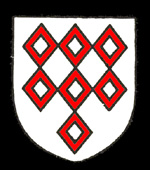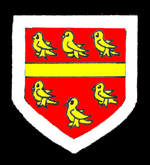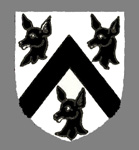A history of the manors of Eastcotts is given in The Victoria County History for Bedfordshire published in 1912. Cotton End Manor was known variously as Cotes Manor, Cotton Manor, Eastcotts Manor and Cardington Cotton End Manor. It seems to have its origin in Nigel de Albini’s manor, the largest of the three held at Harrowden as recorded by the Domesday Book of 1086. Harrowden was the only place in Eastcotts mentioned in the Domesday Book and had three manors. Thus, Cotton End Manor may have extended further than just the settlement of Cotton End to incoude part of Harrowden or what later became Shortstown.
The de Albini family were Barons of Cainhoe and Cotton End Manor stayed in family until 1233 and the death of Robert de Albini. It was then divided between his three sisters Isabel, Ascelina and Joan.

The arms of the Saint Amand family
The manor was eventually re-united in the possession of Amalric, son of Joan and her husband Ralph Saint Amand. The manor remained in the Saint Amand family until 1403 when Almaric de Saint Amand died. He was the last of the line and his estates passed to his grandson, Gerard de Braybrook.

The arms of the Braybrook family
Gerard de Braybrook died in 1427 and his lands passed to Sir William Beauchamp and his wife Elizabeth, Gerard’s daughter. Sir William became Lord Saint Amand in 1449 and died in 1457. His son, Richard, was accused by King Richard III (1483-1485) of plotting with Henry Tudor in 1483 and the following year all his lands were given to Lord Stanley and his son. The Stanleys famously deserted Richard III at the Battle of Bosworth Field in 1485 where he was defeated and killed by Henry Tudor who became King Henry VII (1485-1509). Despite their support, Henry took Lord Saint Amand’s lands from them and restored them to their original owner as soon as he entered power.

The arms of the Beauchamp family, Lords Saint Amand
In 1491 Elizabeth, Richard’s wife, but by then widow of Sir Roger Tocotes held the manor and passed it to her son Richard, who died in 1508 when the title of Saint Amand became extinct. By the 1530s it was held by George, Lord Cobham, who settled it on Richard Osbaldiston around 1534. Two years later Osbaldiston settled on his wife Dorothy, who died four months after him in 1541. Their son John succeeded to the manor who alienated it to Sir George Gascoigne of Cardington in 1544.

Ther arms of the Gascoigne family
Gascoigne mortgaged the manor to Thomas Colby of London in 1566 and a legal dispute arose soon afterwards, presumably for non payment of interest. At any rate Colby took ownership of the manor and it descended to his daughter Dorothy and her husband Philip, Lord Wharton who conveyed it to Robert Mildmay and John Cason for £600 in 1612 or 1613.
By 1633 Sir Arthur Savage died in possession of the manor and was succeeded by his son, but by 1693 it was in the ownership of Charles Palmer who had bought it from the appropriately named Lawrence Purchase. By 1770 it was owned by another Charles Palmer, whose daughter Dorothy sold it in 1779 for £4,000 to Samuel Whitbread of Cardington.

The arms of the Whitbread family
The manor remained in the possession of the Whitbread family into the 20th century. A succession of Law of Property Acts in the 1920s extinguished all manorial incidents, courts and copyhold tenure of land. This effectively abolished manors in all but name.